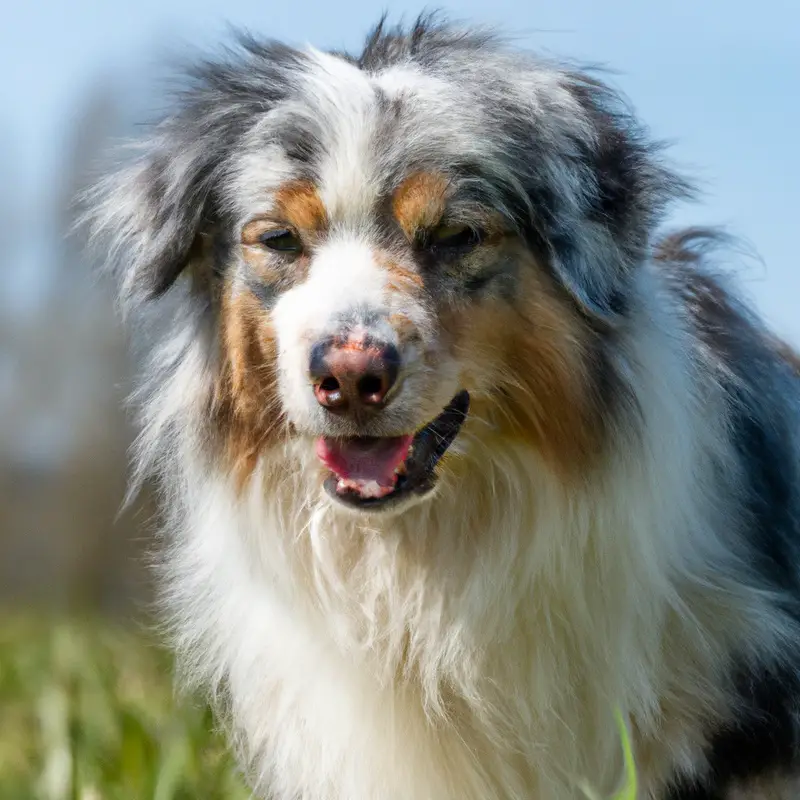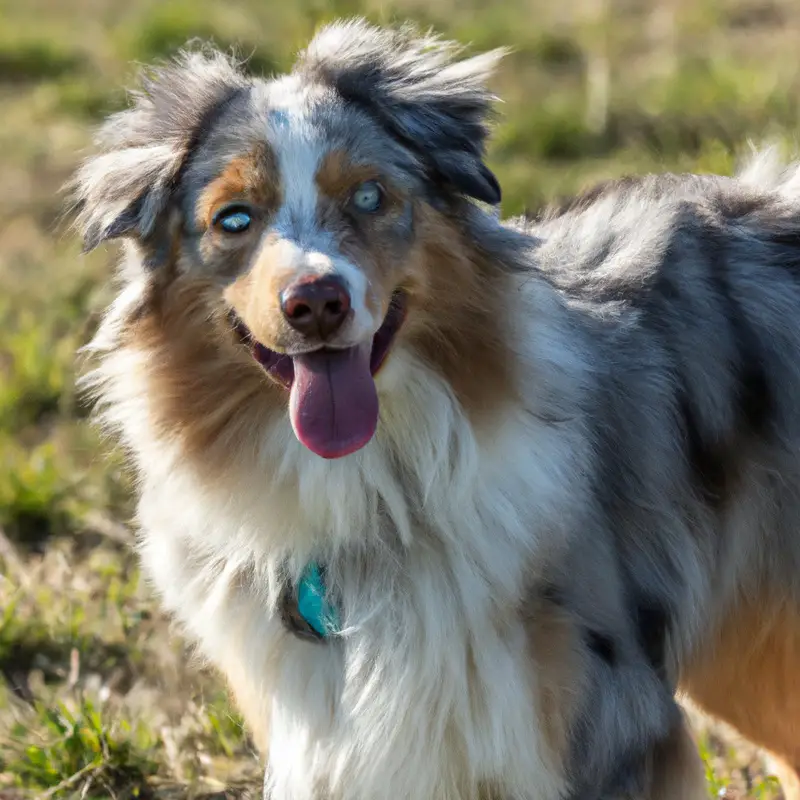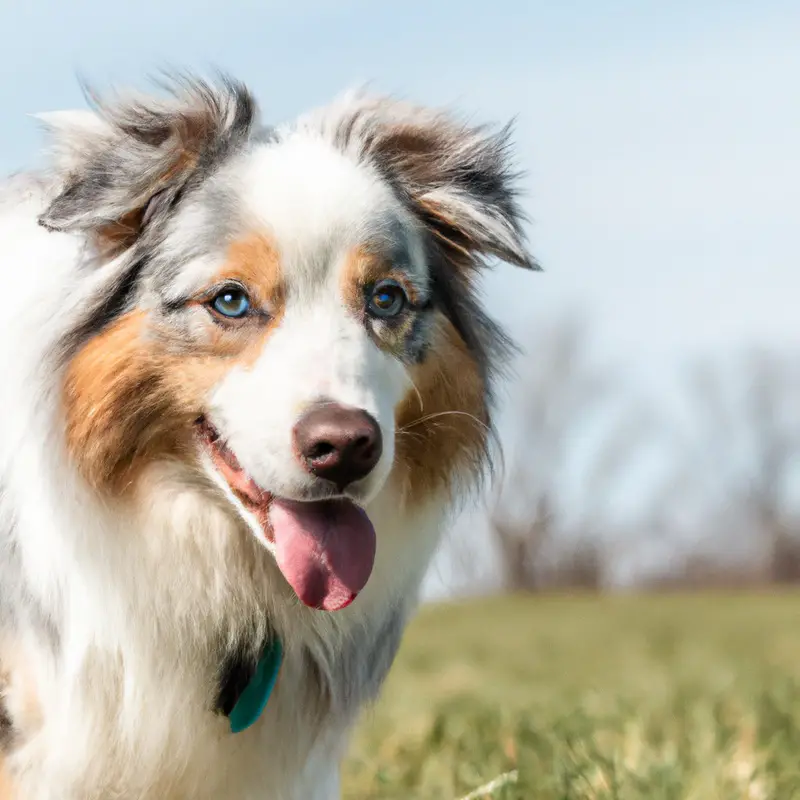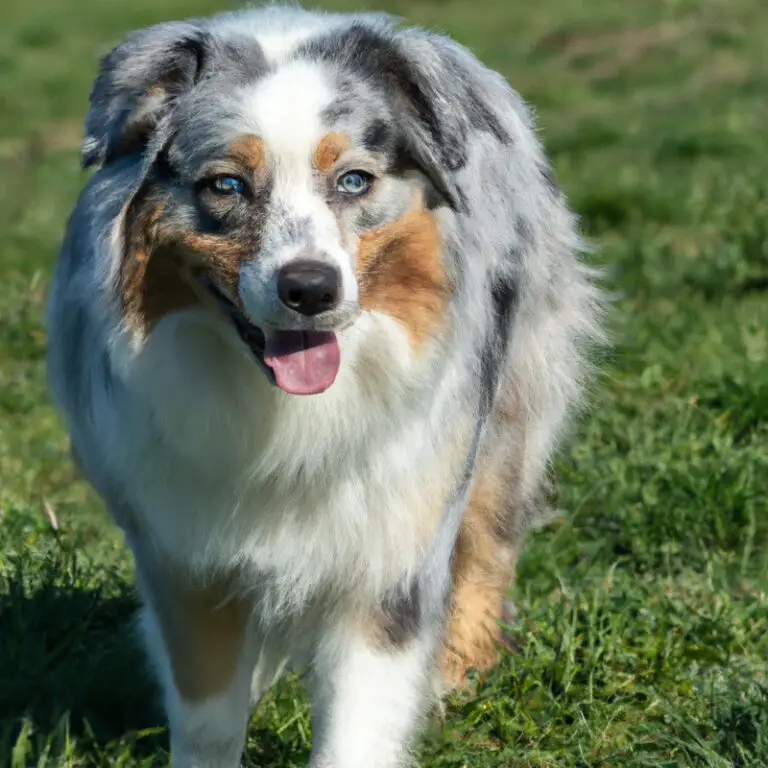How Do Australian Shepherds Behave When Introduced To New Farm Animals?
Key Takeaways:
- Australian Shepherds often show herding instincts when introduced to new farm animals.
- Training and socialization play a key role in how Australian Shepherds behave around new farm animals.
- Australian Shepherds may exhibit both cautious and curious behaviors when introduced to new farm animals.
- The behavior of Australian Shepherds when introduced to new farm animals can be influenced by their individual temperament and previous experiences.
Are you curious about how Australian Shepherds interact with new farm animals? As a passionate dog lover and expert in canine behavior, I’ve got some fascinating insights to share with you.
These intelligent and curious dogs have a natural herding instinct that can play a significant role when they encounter new farm animals.
However, introducing your Australian Shepherd to unfamiliar animals can come with its share of challenges. In this article, I’ll guide you through the process of introducing your Australian Shepherd to new farm animals, step by step, while addressing potential difficulties and offering practical solutions.
Let’s dive in and explore the behavior of these magnificent dogs in the farm setting!
| Australian Shepherds | |
| Introduction to new farm animals | |
| Behavior | |
| Curiosity | |
| Alertness | |
| Herding instinct | |
| Playfulness | |
| Training |
Understanding the Behavior of Australian Shepherds
Herding Instincts of Australian Shepherds
Australian Shepherds are known for their strong herding instincts. These instincts are deeply ingrained in their DNA, as they were originally bred to work alongside farmers and livestock.
When Australian Shepherds are introduced to farm animals, their natural herding instincts may kick in.
These instincts drive them to gather and control livestock by using various techniques such as circling, nipping, and barking. It’s essential to understand that these behaviors are not aggressive, but rather a reflection of their innate herding abilities.
Australian Shepherds have an incredible focus and intelligence, making them excellent herding dogs.
They are quick to learn and can adapt their herding techniques to different types of animals. Their intense drive to work and please their owners makes them highly trainable for herding tasks.
It’s important to note that not all Australian Shepherds will have the same level of herding instincts.
Some may have a stronger drive to herd, while others may exhibit milder behaviors. However, it’s crucial to provide them with appropriate outlets for their instincts, such as participating in herding trials or engaging in activities that simulate herding behaviors.
Understanding and appreciating the herding instincts of Australian Shepherds is key to their overall well-being and fulfillment.
By acknowledging their natural abilities and providing them with appropriate outlets, we can help them lead happy and purposeful lives.
Natural Curiosity of Australian Shepherds
Australian Shepherds have a natural curiosity that drives their behavior. They are known for being inquisitive and eager to explore their surroundings.
This curiosity is a key characteristic of the breed and can be observed in various situations, including when they are introduced to new farm animals.
When faced with unfamiliar animals, Australian Shepherds may show a keen interest and want to investigate further. Their curiosity can be seen in their body language, such as perked ears and an alert posture.
It’s important to harness and channel this curiosity in a positive way, ensuring a smooth introduction to new farm animals.
Keeping them engaged and providing appropriate outlets for their curiosity can help make the introduction process easier.
Potential Challenges in Introducing Australian Shepherds to New Farm Animals
Introducing Australian Shepherds to new farm animals can present some challenges. One potential challenge is that Australian Shepherds have strong herding instincts.
They may try to chase or round up the new animals, which can be disruptive and potentially harmful.
Another challenge is their natural curiosity. They may become overly excited and want to investigate or play with the farm animals, which can lead to unpredictable behavior.
Additionally, fear or anxiety towards the new animals can be a challenge.
Australian Shepherds may feel unsure or threatened, causing them to act defensively or aggressively. Nipping behavior can also be a challenge, especially if they perceive the farm animals as prey.
This can be dangerous for both the Australian Shepherd and the animals they are introduced to.
To overcome these challenges, it is important to properly socialize Australian Shepherds from a young age. Gradual exposure to new farm animals helps them become familiar and comfortable.
Establishing clear boundaries and rules is crucial to ensure their behavior remains controlled and respectful.
Monitoring and supervision are essential during the initial interactions. Watching for signs of stress or aggression allows for intervention and corrective measures to be taken promptly.
By addressing these challenges, Australian Shepherds can learn to coexist peacefully with farm animals and develop a positive relationship over time.
Regular exposure and reinforcement, along with encouraging positive interactions, can help build trust and cooperation. By gradually increasing their exposure to new animals and providing positive experiences, Australian Shepherds can learn to behave appropriately and become valuable farm companions.
Preparation for Introducing Australian Shepherds to New Farm Animals
Proper Socialization Techniques
Proper socialization techniques are essential for introducing Australian Shepherds to new farm animals. Here are some key strategies:
- Positive Exposure: Gradually expose your Australian Shepherd to different farm animals in a controlled and positive environment. Start with animals that are calm and well-behaved.
- Desensitization: Gradual exposure helps your dog become familiar with new sights, sounds, and smells. Use treats and praise to create positive associations.
- Controlled Interactions: Initially, keep interactions between your dog and farm animals short and supervised. Gradually increase the duration as your dog becomes more comfortable.
- Obedience Training: Teach your Australian Shepherd basic obedience commands like “sit,” “stay,” and “leave it.” This will help you have better control over their behavior during introductions.
- Clear Boundaries: Establish clear rules and boundaries for your dog’s behavior around farm animals. Consistency is key for teaching them appropriate manners.
Remember, every dog is different, so be patient and be prepared to tailor your approach based on your Australian Shepherd’s individual needs. With time and proper socialization, your dog can learn to behave calmly and respectfully around new farm animals.
Gradual Exposure to New Farm Animals
When introducing Australian Shepherds to new farm animals, gradual exposure is key. By gradually exposing your Australian Shepherd to the presence of farm animals and allowing them to observe from a safe distance, you can help them become familiar and comfortable with their new companions.
Start by keeping the interactions controlled and supervised, allowing your dog to approach at their own pace.
Reward positive behavior and provide plenty of praise and treats. Over time, increase the proximity and duration of these interactions, always monitoring your dog’s behavior and adjusting accordingly.
By taking it slow, you can help your Australian Shepherd build positive associations and develop a harmonious relationship with their new farm animal friends.

Establishing Clear Boundaries and Rules
Establishing clear boundaries and rules is essential when introducing Australian Shepherds to new farm animals. These guidelines will help create a structured environment and ensure a positive experience for everyone involved.
- Consistency is key. I make sure to set consistent rules and boundaries for my Australian Shepherd right from the start. This helps them understand what behaviors are acceptable and what are not.
- Clear communication. I communicate my expectations to my Australian Shepherd through firm but gentle commands. This helps them understand what I want from them when interacting with the new farm animals.
- Positive reinforcement. I use positive reinforcement techniques such as treats, praise, and rewards to encourage good behavior. When my Australian Shepherd follows the rules and boundaries, I make sure to reward them, reinforcing the desired behavior.
- Supervision and redirection. I always supervise the interactions between my Australian Shepherd and new farm animals. If I notice any behavior that goes against the established rules, I redirect my dog’s attention and guide them towards appropriate behavior.
- Time and patience. Establishing clear boundaries and rules takes time and patience. I understand that it may take a few tries before my Australian Shepherd fully understands and adheres to the guidelines. Consistency, repetition, and positive reinforcement will eventually lead to success.
By setting clear boundaries and rules, I can ensure a safe and harmonious introduction between my Australian Shepherd and new farm animals. It’s important to remember that each dog is unique, and adjustments may be needed based on their individual personality and behavior.

Step-by-Step Introduction Process
Initial Assessment of Australian Shepherd’s Behavior
When assessing an Australian Shepherd’s behavior when introduced to new farm animals, there are a few key factors to consider. Firstly, it’s important to evaluate the dog’s herding instincts.
Australian Shepherds are known for their strong herding drive, so they may naturally be interested in interacting with livestock.
Secondly, you should take into account the dog’s natural curiosity. Australian Shepherds are intelligent and inquisitive by nature, which can influence their behavior when encountering new animals.
They may approach them with excitement and eagerness to explore.
Lastly, it’s crucial to be aware of any potential challenges that may arise during the introduction process. Australian Shepherds may exhibit fear or anxiety towards unfamiliar animals, or they may become overexcited and engage in nip behavior.
It’s important to be prepared for these possibilities and have strategies in place to address them.
By assessing these factors, you can better understand your Australian Shepherd’s behavior when introduced to new farm animals. This knowledge will help you plan and execute a successful introduction process, ensuring the safety and well-being of both your dog and the farm animals.
Controlled Introduction in a Neutral Environment
Controlled introduction in a neutral environment is an important step when introducing Australian Shepherds to new farm animals. It helps create a calm and controlled atmosphere for both the dog and the animals.
Start by bringing the dog on a leash and allowing them to observe the animals from a safe distance.
Gradually decrease the distance between them, always monitoring their behavior closely. Positive reinforcement for calm and appropriate behavior can help reinforce positive associations.
With time and patience, the Australian Shepherd can learn to interact peacefully with the new farm animals.
Positive Reinforcement for Appropriate Behavior
Positive reinforcement is a key strategy when introducing Australian Shepherds to new farm animals. It involves rewarding the dog for exhibiting appropriate behavior during the introduction process.
This method focuses on reinforcing desirable actions, encouraging the dog to repeat them in the future.
One effective way to utilize positive reinforcement is through treats or rewards. When the Australian Shepherd displays calm and gentle behavior towards the new farm animals, such as sniffing them without aggression or excessive excitement, reward them with a small treat or praise.
Additionally, verbal cues and commands can be reinforced with positive reinforcement.
For example, if you instruct the Australian Shepherd to “leave it” when they show interest in chasing or herding the animals, and they comply, reward them with praise or a treat. Consistency is crucial when implementing positive reinforcement.
The dog needs to understand that they are rewarded for appropriate behavior consistently.
This means rewarding them each time they exhibit appropriate behavior throughout the introduction process. By using positive reinforcement, you are creating a positive association between the Australian Shepherd and the new farm animals.
This can help build trust and cooperation over time.
It is important to remember that positive reinforcement should always be used in conjunction with other techniques, such as proper socialization and gradual exposure, to ensure a successful introduction process.

Monitoring and Supervision
Importance of Supervising Initial Interactions
Supervising the initial interactions between an Australian Shepherd and new farm animals is crucial for a smooth introduction. By observing these interactions closely, I can ensure the safety and well-being of both the dog and the animals.
It allows me to intervene if any signs of stress or aggression arise, preventing any potential harm.
Moreover, supervising also helps me to gauge the dog’s behavior and make necessary adjustments to the introduction process. This hands-on approach helps build a positive foundation and sets the stage for a successful long-term relationship between the Australian Shepherd and the new farm animals.
Recognizing Signs of Stress or Aggression
Recognizing signs of stress or aggression is essential when introducing Australian Shepherds to new farm animals. As an expert in dog behavior, I can share some helpful insights.
Here are some common signs to look for:
- Body Language: Watch for signs of tension such as raised hackles, a stiff body posture, or a tucked tail. These indicate that your Australian Shepherd may be feeling stressed or aggressive.
- Vocalizations: Listen for growling, barking, or whimpering sounds. These vocalizations can be an indication of fear, anxiety, or aggression.
- Facial Expressions: Pay attention to your dog’s facial expressions. Dilated pupils, bared teeth, or a wrinkled forehead can suggest stress or aggression.
- Freezing or Stiffness: If your Australian Shepherd freezes or becomes stiff when near farm animals, it could be a sign of stress or aggression. This behavior usually indicates that your dog is unsure or uncomfortable.
- Excessive Salivation or Panting: Keep an eye on your dog’s drooling or excessive panting. These can be signs of stress, especially if they occur in new encounters with farm animals.
- Aggressive Posturing: Be cautious if your Australian Shepherd starts lunging, snarling, or snapping at the new farm animals. These aggressive behaviors need to be addressed with corrective measures.
Remember, it’s important to observe your dog closely during introductions and seek the assistance of a professional trainer if you notice signs of stress or aggression. With proper management and training, you can help your Australian Shepherd adjust and develop positive relationships with new farm animals.
Interventions and Corrective Measures
When it comes to interventions and corrective measures for introducing Australian Shepherds to new farm animals, there are a few important things to keep in mind. Firstly, if you notice any signs of stress or aggression during the initial interactions, it’s crucial to intervene immediately.
This may involve separating the animals or redirecting their attention to something more positive.
Secondly, positive reinforcement plays a significant role in shaping their behavior. By rewarding good behavior with treats, praise, or playtime, you can encourage your Australian Shepherd to associate positive experiences with the new farm animals.
Thirdly, consistent and clear communication is key.
It’s important to establish and enforce boundaries and rules for the interaction between your Australian Shepherd and the farm animals. This can help prevent any misunderstandings and ensure everyone’s safety.
Overall, remember to be patient throughout the process.
Each dog is different, and it may take time for your Australian Shepherd to adjust to the presence of new farm animals. By implementing these interventions and corrective measures, you can help facilitate a positive and harmonious relationship between your Australian Shepherd and the farm animals.
Common Challenges and Solutions
Fear or Anxiety towards New Farm Animals
Fear or anxiety towards new farm animals can be a common challenge when introducing Australian Shepherds to them. These dogs may feel unsure or threatened by unfamiliar animals, leading to fear-based behaviors.
It’s important to approach this situation with patience and understanding.
One way to address fear or anxiety is through proper socialization techniques. Gradually exposing your Australian Shepherd to new farm animals in a controlled and positive environment can help them become more comfortable.
It’s crucial to establish clear boundaries and rules, providing your dog with a sense of security.
Monitoring and supervision during initial interactions is also important. By observing your Australian Shepherd’s behavior closely, you can recognize signs of stress or aggression.
If any issues arise, it’s essential to intervene and provide corrective measures to prevent negative experiences.
Building a positive relationship over time is key. Regular exposure to new farm animals, along with positive reinforcement for appropriate behavior, can help your Australian Shepherd develop trust and cooperation.
Encouraging positive interactions and rewarding calmness can go a long way in reducing fear or anxiety.
Remember, every Australian Shepherd is unique, and the process of introducing them to new farm animals may vary. It’s crucial to tailor the approach to your individual dog’s needs and personality.
With patience, consistency, and understanding, you can help your Australian Shepherd overcome fear or anxiety and establish a positive relationship with farm animals.
Overexcitement or Nipping Behavior
Overexcitement or nipping behavior is a common challenge when introducing Australian Shepherds to new farm animals. These dogs have a strong herding instinct and can become overly excited or even nip at the animals.
To address this behavior, it’s important to provide proper socialization and gradually expose your Australian Shepherd to the new farm animals.
Establish clear boundaries and rules right from the start to help them understand what behavior is acceptable. During the step-by-step introduction process, assess your dog’s behavior and start with controlled introductions in a neutral environment.
Use positive reinforcement to reward appropriate behavior and redirect their focus if they become too excited.
Monitoring and supervision are crucial during the initial interactions. Watch for signs of stress or aggression, and intervene or apply corrective measures if necessary.
It’s important to ensure the safety of both your dog and the farm animals.
Building a positive relationship takes time. Regular exposure and reinforcement will help your Australian Shepherd become more comfortable around the farm animals.
Encourage positive interactions and foster trust and cooperation through patience and consistency.
By addressing overexcitement or nipping behavior early on and employing these strategies, you can help your Australian Shepherd develop a harmonious relationship with new farm animals and ensure a safe and enjoyable environment for everyone involved.
Resource Guarding or Prey Drive
Resource guarding or prey drive can be a common challenge when introducing Australian Shepherds to new farm animals. Resource guarding refers to the dog’s instinctual behavior of protecting valuable resources, such as food, toys, or territory.
On the other hand, prey drive refers to their natural instinct to chase and capture smaller animals.
When it comes to resource guarding, Australian Shepherds may exhibit possessive behaviors towards food or toys, which can lead to aggression if not addressed properly. It is important to establish clear boundaries and rules from the beginning, ensuring that the dog understands that their resources are provided by you and can be shared.
Prey drive, on the other hand, can make it challenging to introduce Australian Shepherds to small farm animals, such as chickens or rabbits.
Their strong instinct to chase and capture can result in harm to the animals if not carefully managed. Gradual exposure, controlled introductions, and positive reinforcement for appropriate behavior are key in addressing this challenge.
By monitoring and supervising initial interactions, you can ensure the safety of both the Australian Shepherd and the farm animals.
It is crucial to recognize signs of stress or aggression and intervene when necessary. Corrective measures may include redirecting the dog’s attention, using positive reinforcement, or temporarily separating them until they can be reintroduced in a controlled setting.
Building a positive relationship over time is essential.
Regular exposure and reinforcement will help the Australian Shepherd adjust to the presence of new farm animals. Encouraging positive interactions and fostering trust and cooperation is the key to successful integration.
Remember, addressing resource guarding or prey drive requires patience, consistency, and a proactive approach.
Seek guidance from a professional dog trainer or behaviorist if needed.
Building a Positive Relationship over Time
Regular Exposure and Reinforcement
Regular exposure and reinforcement are key in helping Australian Shepherds develop positive behaviors around new farm animals. To start, it’s important to gradually expose your Australian Shepherd to different farm animals on a regular basis.
This can be done through controlled interactions in a neutral environment.
By exposing them regularly, the Australian Shepherd will become familiar with the sights, smells, and sounds of the farm animals, reducing their fear or anxiety. Reinforcement also plays a vital role in shaping their behavior.
Whenever your Australian Shepherd displays appropriate behavior around the farm animals, reward them with praise, treats, or playtime.
This positive reinforcement will reinforce their good behavior and encourage them to continue behaving calmly and appropriately. Consistency is key when it comes to regular exposure and reinforcement.
Make it a part of your routine to expose your Australian Shepherd to farm animals regularly and consistently reinforce their positive behaviors.
Over time, this repetition will help strengthen their behavior around the animals and establish a positive relationship. Remember, every dog is unique, so it’s important to be patient and understanding during this process.
With regular exposure and reinforcement, your Australian Shepherd will gradually become more comfortable and well-behaved around new farm animals.
Encouraging Positive Interactions
Encouraging positive interactions between Australian Shepherds and new farm animals is essential for building a harmonious relationship. One effective way to do this is by allowing them to engage in supervised and controlled interactions.
Start by introducing the Australian Shepherd to the farm animal in a neutral environment.
This helps reduce any initial territorial or defensive behaviors. Reward the Australian Shepherd with treats or praise when they display calm and friendly behavior towards the new animal.
It’s important to monitor their interactions closely to ensure the safety of both the dog and the farm animal.
If either party shows signs of stress or aggression, it’s crucial to intervene immediately and remove them from the situation. Consistent exposure to the farm animals will help the Australian Shepherd become more familiar and comfortable with them.
Gradually increase the duration and intensity of the interactions over time.
By continuously reinforcing positive behavior and providing a safe and controlled environment, you’ll be able to encourage positive interactions between your Australian Shepherd and the new farm animals. This will help foster trust and cooperation, creating a strong bond over time.
Fostering Trust and Cooperation
When it comes to fostering trust and cooperation between Australian Shepherds and new farm animals, it’s important to take a patient and consistent approach. Building a positive relationship over time requires regular exposure and reinforcement.
One way to encourage trust and cooperation is to engage in activities that involve both the Australian Shepherd and the farm animals, such as training sessions or playtime.
This helps them become more familiar with each other’s presence and promotes positive interactions. Another crucial aspect is to reward the Australian Shepherd for exhibiting calm and appropriate behavior around the farm animals.
Positive reinforcement, like treats or praise, can reinforce the desired behavior and reinforce trust and cooperation.
In addition, allowing the Australian Shepherd to have supervised and controlled interactions with the farm animals can help build trust. This should be done gradually, with close monitoring to ensure the safety of both the dog and the animals.
Lastly, consistency is key.
By providing regular exposure to the farm animals and consistently reinforcing positive behavior, the Australian Shepherd will learn to trust and cooperate with them over time. This process may take time and patience, but with gentle guidance, it is possible to build a positive relationship between Australian Shepherds and new farm animals.
Final Verdict
Introducing Australian Shepherds to new farm animals requires careful preparation, patience, and supervision. Their herding instincts and natural curiosity may present challenges, but with the right socialization techniques and gradual exposure, a positive relationship can be built over time.
It is crucial to monitor initial interactions, recognize signs of stress or aggression, and intervene if necessary.
Common challenges such as fear, overexcitement, and resource guarding can be overcome by consistently reinforcing positive behavior and fostering trust. By following these steps, Australian Shepherds can develop a harmonious relationship with farm animals, creating a safe and productive environment on the farm.
Trust me, as an expert in dog behavior, these techniques will make the introduction process smoother and enhance the bond between Australian Shepherds and farm animals.







